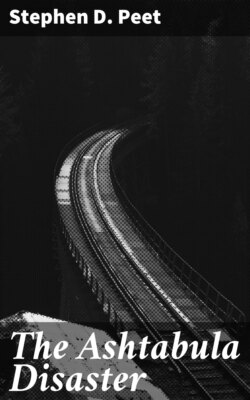Читать книгу The Ashtabula Disaster - Stephen D. Peet - Страница 6
CHAPTER II.
THE RIVER AND THE BRIDGE.
ОглавлениеThe Ashtabula river is a shallow stream which runs through the county and the town. As it approaches the lake it widens and deepens into what constitutes the harbor.
The banks lining the valley of it are high and rocky precipices. They form in the rear or to the southward of the town a gorge which is called, by the inhabitants, by the significant name “the gulf.” Near the depot this gorge widens, and its banks become less precipitous; but, even at this point, the river flows at least seventy-six feet below the level of the road, and is four feet deep. Here the fatal, but far-famed, bridge was built. A grade on an arched viaduct conveyed the track to the abutments, but these stood by themselves, straight from the bottom of the gorge, two lofty pillars of stone seventy-six feet high and just wide enough for the two tracks of the road. Flanking these were the lower and smaller abutments of an older bridge, left standing, but, for a long time, unused. The span of the bridge across this gorge, from abutment to abutment, was the unusual length of one hundred and fifty feet. The bridge was very high, and loomed up in the distance, tall and dark and gloomy.
Travelers by the wagon road, at a distance up the river a mile away, would stop and look at this structure, apparently built high in air, and watch the cars as they passed in bold relief against the sky, almost as if a spectre train were traversing the blue vault above.
It was a dizzy height. There was something almost fearful in the sight. The recklessness of danger impressed the observer. As the full outline marked itself against the sky, the fascination at times almost reached a sense of the sublime.
Here, then, was the bridge suspended high in air, lofty and tall and dark, a mysterious thing. It was not an arch lifting high its springing sides, it was not a set of beams supported by abutments below; it was a web of iron netted and braced and bolted, heavy, dark and gloomy in appearance, and proving treacherous as death.
This bridge was erected in the year 1865, by Mr. Tomlinson, according to orders and patterns given by Mr. Amasa Stone, then president of the road. It was built after the pattern of the Howe Truss, but containing some elements introduced by the president himself. It was constructed of wrought iron, with long iron braces from lower cord to upper cord twenty feet in height. There were rods stretching from top to bottom and designed to carry the strain from brace to brace. The panels were eleven feet long, and between these the strength of the cords depended on three iron beams six inches thick and eight inches wide. The whole width of the bridge was nineteen and one-half feet; its height twenty feet; its length one hundred and sixty-five feet, in a single span.
When it was first erected it was discovered that the braces were placed wrong, so that they came upon the sides rather than upon the edges. The structure settled, as the edges were removed, about six inches, and necessitated the change of the process.
This error was remedied by the cutting away of iron, so that the braces could be turned, and this change occupied nearly a year. It was watched with interest by the citizens, and was regarded by the builders themselves as a doubtful experiment.
In its erection Mr. Tomlinson, the engineer, differed with the president so much that he resigned his position, and, even Mr. Charles Collins never acknowledged that it was a work of his inventing, or a bridge receiving his approval. Before the committee, appointed by the legislature of Ohio, he acknowledged that it was an “experiment,” and even when it was in process of erection he gave no orders, but rather left the responsibility with the president.
The deficiencies of the bridge, as acknowledged by Mr. Tomlinson, who made the drafts, were that the braces were smaller than was intended, and the weight was very great. Its dead weight was 3,000 pounds to the square foot, making an aggregate mass of iron of many tons.
The rods or braces had buckled or bent at the first trial, and there was danger that it would fall by its own weight into the creek. As it was changed, however, and the braces sprang back, by the elasticity of the iron, heavier braces were put into it, and in this shape it stood for eleven years in constant service.
